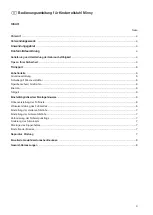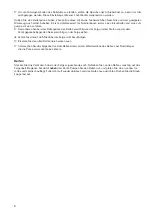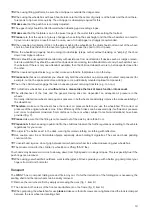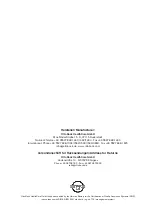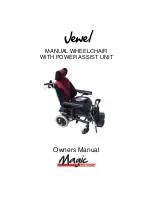
13
When using lifting platforms, be sure the anti-tipper is outside the danger-area.
When using the wheelchair with push handle take note that the center of gravity is at the back and the chair there-
fore tends to tip over more quickly. The anti-tipper is absolutely required for this.
Make sure
that the push bar is correctly adjusted.
The upper body should be tilted forward when wheeling up ascending slopes.
Make sure
that the footplate is not in the swivel range of the caster forks when setting the footrest.
Please
note that the center of gravity changes when setting the seat height and that the wheelchair can tend to
tip over more easily as a result. In such a case, use of an anti-tipper is strongly recommended.
When reaching for objects in front, to the side or behind the wheelchair, the child should not lean out of the wheel-
chair too far since the shift in the center of gravity might cause the chair to tilt or tip over.
Use the wheelchair properly. Avoid running into obstacles (steps, curbs) without breaking or “jumping” the chair
down from higher surfaces.
Stairs should be ascended/ descended only with assistance from an attendant. If devices such as ramps or eleva-
tors are available, they should be used. If such devices are missing, two attendants must carry the wheelchair over
the obstacle. If there is only one attendant available, then the child and wheelchair are to be transported one after
the other.
When overcoming obstacles (e.g. curbs), make sure that the footplate is not on the step.
Please note
that as an attendant you should only hold the wheelchair on permanently mounted components (for
example, not on the spoke protectors, anti-tipper or on additionally mounted optional components).
You or the child should engage the lock on uneven ground or during transfers (e.g. to a car).
If a children‘s wheelchair is used
without a lock, please take the lack of break function into account.
The effectiveness of the lock and the general driving ease are dependent on adequate air pressure in the
wheels.
Correctly inflated rear wheels and equal air pressure in both wheels considerably improve the maneuverability of
the wheelchair.
Therefore,
make sure the wheels have the correct air pressure before you use the wheelchair. The correct air
pressure of the original wheels is max. 9 bar. Efficiency of the brakes can be ensured only if sufficient air pressure
and correct adjustment (maximum 5 mm distance to the rear wheel, subject to technical alterations) have been
provided (fig. 7).
Please
make sure that the fitting is not screwed out of the axis by more than 2 cm.
Please note
that when using in public traffic, the child must observe the traffic regulations according to the vehicle
regulations for your area.
In order to “be better seen” in the dark, wear light-colored clothing or clothing with reflectors.
Use caution near fire or flammable objects, especially when holding lit cigarettes. The seat and back padding
could catch fire.
To avoid hand injuries, do not grip between rear wheel and wheel lock while maneuvering your wheelchair.
The maximum load for the children‘s wheelchair is 25 kg (55.12 lbs.).
Your hands may become warm due to slowing down from high speed or on longer slopes. This is especially true if the
push rings are aluminum.
When using your wheelchair outdoors, wear leather gloves. Gloves provide you with a better grip and protect your
fingers from dirt and hot metal.
Transport
The MINNY has a compact folding size and fits in any car. If a further reduction of the folding size is necessary, the
seating shell and the rear wheels can be easily removed.
Remove the rear wheels first by simply unscrewing the axes (fig. 1, item A).
Then loosen both screws of the front seat attachment on the frame (fig. 2, item A).
When preparing the wheelchair for use
please
make sure that all screws are re-tightened and the lock is clamped
between the rear wheel and seating shell.



